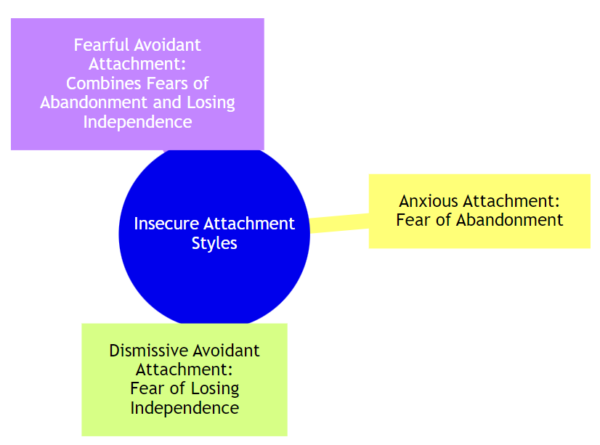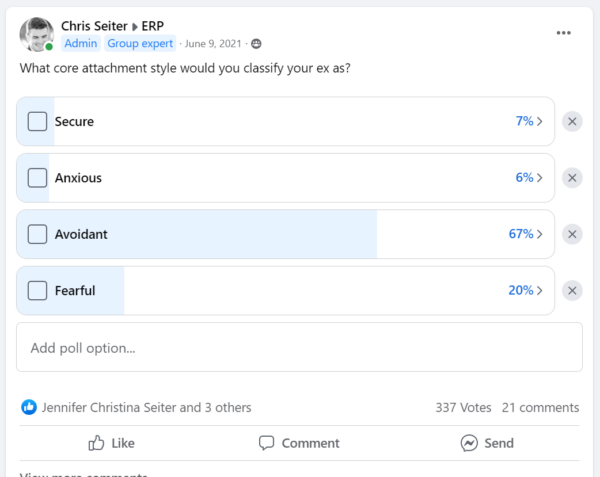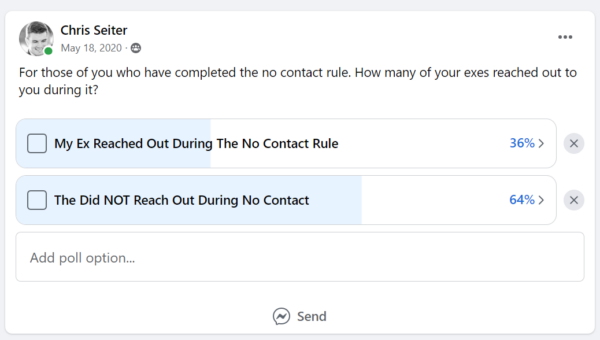Today I’m going to show you how to tell if your ex is a fearful or a dismissive avoidant.
In my opinion, the biggest difference between fearful avoidants and dismissive avoidants is that after a breakup dismissive tend to “detach completely” appearing in some cases to be unaffected, while fearful avoidants exhibit a push-pull pattern with a tumultuous range of emotions.
But there’s actually a lot more to talk about here.
- You need to understand the core wounds of attachment styles
- How the dismissive avoidants and fearful avoidants handle the no contact rule
- I want to take a look at two real life examples to show you what each of these attachment styles looks like in real time
Let’s begin!

What Are Your Chances of Getting Your Ex Boyfriend Back?
Take the quizUnderstanding The Core Wounds
When you’re talking about differentiating between the two types of avoidance, perhaps there’s no better indicator than the concept of core wounds.
A core wound, something I’ve discussed in nearly every article about attachment styles, is essentially the wound that lives inside each insecure attachment. Once triggered, it causes that insecure attachment to exhibit its typical behavior. For example, if the core wound of an anxious person is triggered, they will act in incredibly anxious ways. Similarly, for an avoidant person, triggering their core wound leads to extremely avoidant behavior. By understanding the core wound, you can differentiate between all the different insecure attachment styles.
Although this discussion is primarily about fearful and dismissive attachments, to get the full scope, it’s important to understand how anxious attachments work.
Therefore, we’re going to look at three core wounds today.
- Anxious Core Wounds
- Avoidant Core Wounds
- Fearful Core Wounds
The Anxious Core Wound
Let’s start with the anxious attachment core wound, which is a fear of abandonment.
Whenever someone with an anxious attachment feels they are being abandoned, or the threat of abandonment arises, their anxious behaviors also emerge. This is why the anxious attachment style tends to seek reassurance more than other styles; they’re afraid of being abandoned.
The Avoidant Core Wound
The avoidant core wound revolves around losing their independence.
Avoidants, often described as lone wolves (a description I somewhat loathe), want relationships but are incredibly self-sufficient and independent. When they feel their independence is being compromised in a relationship, they put up walls and start avoiding conflict or disengaging altogether.
The Fearful Core Wound
Now, the fearful core wound is unique as it contains both the anxious and avoidant core wounds. A fearful person fears both abandonment and losing their independence. I describe the fearful attachment style as a pendulum swing.
If something in a relationship triggers their fear of abandonment, their anxious side is activated, leading to anxious behavior.
What’s frustrating about this style is that when their anxious side is triggered and you try to provide validation, if it’s overdone, it can trigger their fear of losing independence. This can make being in a relationship with a fearful avoidant feel like dealing with two different people.
It’s akin to dealing with someone with bipolar disorder, where one minute everything seems great, and the next, there’s a problem. When you try to fix that problem, they may resent you for it, creating a challenging cycle. That is the fearful attachment style.
How To Differentiate Between Fearful And Dismissive Avoidants During No Contact?
Well, I actually think, especially since this discussion is geared towards exes, that looking at a core pillar strategy can help us understand how the two operate a little differently.
As many of you know, the no contact rule is something that pretty much every breakup coach, guru, you name it, will talk about. They always recommend some form of the no contact rule.

What Are Your Chances of Getting Your Ex Boyfriend Back?
Take the quizI’ve always found it incredibly exciting to study how exes respond to the no contact rule. The natural assumption is that you’re going to do this no contact rule and it’s going to make your ex miss you, right?
You cut off all communication for a certain period of time and all of a sudden your ex misses you.
But what if I were to tell you that that’s actually not the case?
Taking A Look At Dismissive Avoidants During No Contact
We’ve found that most of our clients are trying to get back with or get over dismissive avoidant exes.
When I actually polled our community a couple of years ago and asked them, ‘For those of you who’ve completed a no contact rule, how many of your exes have reached out to you during it?’
- Only 36% said that their ex actually did reach out to them during the no contact rule.
- A whopping 64% said that their exes did not reach out to them.
This is pretty consistent with what we know about dismissive avoidants.
They tend to disengage, detach completely, and sometimes appear unaffected by the detachment. So, what’s ultimately happening here is you have this ex who is a dismissive avoidant, you’re using the no contact rule on them, and you’re actually giving them what they want. And this is not necessarily a bad thing.
I’ve written multiple articles and filmed multiple videos about how you actually need them to move on from you for you to get them back, which is a really weird misunderstanding that people have.
But we’re looking at how to differentiate between fearfuls and dismissives during the no contact rule.
The first thing you’ll notice with dismissive avoidants is they’re not going to contact you during no contact. In fact, they prefer it. They enjoy getting their independence back.
This is wildly different from the experience of a fearful avoidant.
Taking A Look At The Fearful Avoidant During No Contact
So, a fearful avoidant, when you use the no contact rule on them, probably nine times out of ten, you can expect them to trigger their anxious side.
You usually hear from a fearful avoidant during the no contact rule. But this is what makes fearfuls incredibly difficult to deal with. You’ll hear from them during the no contact rule, but let’s say you decide you’re going to stick to the no contact rule and you are not going to break it no matter what.
By not nurturing that anxious side, this will cause the fearful avoidant to trigger their avoidance side. And they’ll dig in deeper on that avoidance side. It’ll take longer for them to have that anxious side triggered again.
One of the big differences between the two is actually the timeframes we recommend.
- For dismissive avoidants, we recommend 45 days of no contact. We want the dismissive avoidant to have space from you. We know that the only way a dismissive avoidant ex will miss you after a breakup is if they feel as if you’ve moved on from them. So more space is good. The opposite is true for fearfuls. Not a lot of space is good. In fact, you get this digging in deeper on the avoidant attachment wound if you don’t nurture their anxious side.
- So we only recommend 21 days for people who have fearful avoidant exes. This is why it’s really important to understand your ex’s attachment style or take your best guess at what your ex’s attachment style is before you actually implement a no contact rule. Because I think it is essential to understanding the time period.
Let’s take a look at a couple of real-life examples though.
Real Life Examples Of Dismissive Avoidants And Fearful Avoidants
One of the things that always kind of annoys me about articles online is the fact that you’re hearing all of the research.

What Are Your Chances of Getting Your Ex Boyfriend Back?
Take the quizI’m showing you,
- ‘Hey, this is what the core attachment style of your ex probably looks like.
- Hey, this is how they’ll respond to you during no contact.
- Hey, these are the differences between the two attachment styles.’
It’s one thing to read about it, but it’s another thing to actually watch it occur.
Now, luckily, we’ve been blessed with lots of different success stories, and I’ve handpicked two that I would like to highlight today. One is about a woman named Regina who got her dismissive avoidant ex back and details her experience.
The other is about a woman named Heather who got her fearful avoidant ex back and shares her story.
Regina (Got Back With Dismissive Ex):
Listen To The Full Interview Here
- Ex-Boyfriend’s Profile: Her ex-boyfriend was identified as having a dismissive avoidant attachment style, characterized by emotional distance and independence.
- Her Strategy:
- Understanding Attachment Styles: She educated herself about different attachment styles to better understand her ex-boyfriend’s behavior.
- No Contact Rule: She implemented the no contact rule, giving both of them space and time to reflect.
- Self-Improvement: During the no contact period, she focused on her own growth and healing.
- Re-establishing Contact: When she reinitiated contact, she did so with an understanding of his attachment style, ensuring she didn’t push too hard.
- Patience and Understanding: She showed patience and understanding towards his need for space.
- Outcome: Her approach led to a positive change in their relationship dynamics, and they eventually got back together.
- Key Takeaways:
- Importance of Understanding Attachment Styles: Recognizing and adapting to different attachment styles can significantly impact relationships.
- Self-Growth: Focusing on personal growth during a breakup can be beneficial.
- Patience and Empathy: Being patient and empathetic towards an ex-partner’s needs and attachment style can help in reconciling.
So, the big thing to note in Regina’s situation is that she really adopted the ‘when they pull back, you pull back’ concept. This approach is essential for both attachment styles, but it’s particularly effective with dismissive avoidants.
If you overcrowd them, they will just dig in deeper and avoid you more. It’s all about showing your ex that you can take a step back. While that may seem simple to us, it is profound for them because they often have preconceived notions about you.
They don’t think you can take a step back.
So, when you actually do, it’s like speaking their language, and it draws them back in, not always, but generally. Regina did a wonderful job of this. She talked a lot about the no contact rule and how it gave them both time and space to reflect, how she focused on growth and healing. All of this is essential, as I’ve said before.
Avoidants tend not to miss you until they feel like they’re over you and you are over them.
That’s when they allow themselves to put those walls down and miss you. Regina created an environment conducive to this.
Now let’s move on to Heather, who got her fearful avoidant ex back.
Heather (Got Back With A Fearful Avoidant):
- The Challenge: Heather faced the challenge of understanding and adapting to her ex-boyfriend’s fearful-avoidant attachment style, which is characterized by a desire for close relationships but a fear of getting too emotionally attached.
- Strategies Used:
- No Contact Rule: She implemented a period of no contact, giving both parties time to reflect and heal.
- Self-Improvement: During the no-contact period, she focused on self-improvement and personal growth.
- Understanding Attachment Styles: She educated herself on different attachment styles, particularly the fearful-avoidant type, to better understand her ex-boyfriend’s behavior and needs.
- Effective Communication: Upon reinitiating contact, she employed effective communication strategies, showing understanding and patience.
- Outcome: These strategies led to a successful reconciliation with her ex-boyfriend.
- Expert Insights: The interview includes insights from me and emphasizes the importance of understanding attachment styles in relationships and the effectiveness of the no-contact rule and self-improvement in winning an ex back.
- Broader Implications: The story serves as an example and guidance for others in similar situations, demonstrating the importance of personal growth and understanding in rekindling relationships.
The thing that really stood out to me about Heather’s story was how the on-again, off-again nature of the situation, which is essentially the hallmark of a fearful avoidant. Their avoidance side gets triggered, then their anxious side, and it goes back and forth.
It takes an incredible amount of patience to deal with someone like this. That is probably Heather’s superpower – her patience. And that’s something a lot of people overlook when dealing with fearful avoidants. Let’s hear from the woman herself. In the interview, I literally asked her, ‘Hey, what do you think the most important thing you learned from this experience was?’
Here’s what she had to say.
Heather: “Okay. For me, personally, I think… I actually mentioned this before, not during the podcast, but I needed to regain my confidence and bring back the dynamic where I wasn’t being meek, trying to make him happy and scared he might leave. Instead, I wanted to be a partner where we could have that banter.”
Chris Seiter: “That’s equal.”
Heather: “Yes, exactly, very equal. I truly needed that balance back in the relationship for it to work. He knew that. Now that it’s back, we’re both so comfortable. I needed to boost my confidence so we could restore that sense of equality in our relationship, which he also wants. He didn’t like it when I was meek. This change was really good. I can’t tell you how much I needed that.”
Heather: “Then, I think the most important thing for the relationship, as we just discussed, was me learning that he needs to process things a bit differently than I do. And that’s fine, as long as I recognize it. I’m more than willing to give him that time.”
So, based on her statements I think the key takeaways are:
- Importance of Self-Confidence: Heather emphasizes the need to regain her confidence. This suggests that self-assurance is crucial in how she perceives herself and interacts in the relationship.
- Desire for Equality in the Relationship: She stresses the importance of having an equal partnership. This indicates her realization that a healthy relationship requires both partners to be on an equal footing, rather than one being submissive or meek.
- Significance of Personal Growth: Heather’s journey to regain her confidence and strive for equality reflects personal growth. It shows her understanding that for the relationship to work, she needed to evolve and change certain aspects of herself.
- Understanding and Respecting Partner’s Needs: She acknowledges the need to understand and respect how her partner processes things differently. This shows her maturity and willingness to accommodate her partner’s unique emotional processing methods.
- Communication and Mutual Comfort: Heather’s reference to being comfortable now that things have changed suggests that effective communication and mutual understanding have significantly improved the comfort level in their relationship.
- Partner’s Preferences: She notes that her partner didn’t appreciate her being meek, indicating an awareness of her partner’s needs and preferences, and how her behavior affects the relationship dynamics.
- Value of Balance: The overall discussion points towards the value of balance in a relationship – balancing self-improvement with understanding the partner, and balancing individual needs with relationship dynamics.



